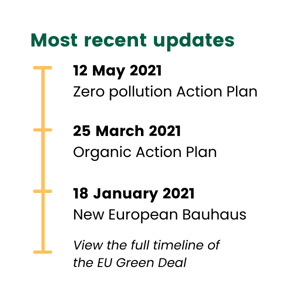
Long before the EU Green Deal was the reality of today’s headlines, there was nothing but the ideas behind it. The catchy phrase “green deal” was coined about 15 years ago for the concept of a government-led reboot of industry and infrastructure to fight climate change. In theory, it’s nebulous with millions of possible implementations along the entire spectrum of political ideologies, with countless potential branches and off-shoots of government policy. But in practice, the European Union’s effort as the first-ever governing body to implement a green deal is clear and defined. Here’s a breakdown of its essentials: what the EU Green Deal is, why it was created, how it will be implemented, and more.
Download and get one step closer to align with, and implement, the European Green Deal policies in your organizations' work with sustainable investments.
What essentially is the EU Green Deal?
The EU Green Deal is a coordinated set of policies and legislation designed to lower the European Union’s global warming emissions to zero over the next 30 years. It intends to not only do so without diminishing the EU’s economy but while also improving the quality of life for the nearly half-billion people who live within the European Union.
If that sounds like a momentous task, those setting out to achieve it are well aware of the fact. European commission president Ursula von der Leyen famously called the EU Green Deal “Europe’s man on the moon moment.”
The European Green Deal – A commitment to future generations.
Source: European Commission
Why was the EU Green Deal created?
Presented publicly at the end of 2019, the EU Green Deal is based in accordance with the parameters set by the 2016 Paris Agreement – which aims to prevent a rise of global temperature in the 21st century to under 2 degrees Celsius, as well as additionally trying to limit that temperature increase even further to 1.5 degrees Celsius.
For the 27 nations that make up the EU to do their part in meeting those goals, they need to cut emissions 50%-55% by 2030 (which equates to a 40% reduction of emission levels in 1990). And then, by 2050, for the entire block of nations to emit no climate-heating gases into the atmosphere at all.
Would you like to dig deeper into the climate-heating gases? Start with our blog post What Are Scope Emissions: A Short Guide.
How does the European Union plan on implementing the European Green Deal?
Because of its enormous goals, the EU Green Deal is incredibly complex. It’s a massive and intricate collection of policies: new and updated regulations, incentives for encouraging private sector investment, and action plans for specific goals and focused areas of policy.
At its heart is the European Climate Law, which officially sets the goal for net-zero emissions by 2050, creates a system for monitoring progress, and makes the effort legally binding and irreversible. Although it has not yet been formally adopted, the European Parliament and Council made a provisional agreement to the law in late April of 2021.
Along with the legal obligation of the Climate Law and efforts to meet its goals, the European Green Deal includes two additional objectives:
- Boosting the efficient use of resources by moving to a clean, circular economy
- Restoring biodiversity and cut pollution
In order to meet all of its objectives, the Green Deal’s policies focus on seven areas:
- Climate action — for making the EU climate neutral by 2050.
- Eliminating pollution — for efforts to cut pollution rapidly and efficiently.
- Sustainable mobility — for promoting the roll-out of cleaner, cheaper, and healthier forms of transport, both private and public.
-
Building and renovation — for ensuring buildings are more energy efficient.
- Sustainable industry — for ways to ensure production cycles that are more sustainable and more environmentally respectful.
- Clean energy — for decarbonizing the energy sector.
- Sustainable agriculture — for common agricultural policy (CAP) that ensures the EU’s agriculture is socially, economically, and environmentally sustainable.
- From farm to fork — for ways to ensure more sustainable food systems.
- Biodiversity — for restoring degraded ecosystems and helping to reach a balance with nature. Here's an overview that guides you though What is the Biodiversity Strategy for 2030?
Another significant component is the Just Transition Mechanism (JTM), which helps ensure that no one is left behind by the inevitable economic changes of Europe moving to net-zero emissions by providing targeted support to alleviate the socio-economic impact in the most affected regions, like countries that are still heavily dependent on fossil fuels.
Additionally, there are provisions within the EU Green Deal that specify investing in environmentally-friendly technologies, supporting industry to innovate, and working with international partners to improve global environmental standards.
Most of the financing for the initiatives will come from the EU’s budget, but the plan also includes policies to encourage investment from the private sectors with loan guarantees from the European Investment Bank, the lending arm of the EU.
One way of implementing the EU Green Deal, and thereby scale-up your sustainable investment, is to align with The EU taxonomy. Download our EU Taxonomy Guide - Are You Affected? and learn how to navigate the legal requirements.
What industries will the EU Green Deal affect the most?
It’s not hyperbolic to say that the European Green Deal will affect every industry within the European Union. But some businesses will be impacted more than others. Most analysts predict that reform will be divided between two types of industries: financial and “real economy” (meaning the production and flow of goods and services within an economy).
Financial Industry
For the financial industry, this means a more significant effort to promote and secure sustainable investments with increased regulation and subsidization. So firms and financial institutions specializing in those areas will see more activities than others.
Real Economy Industries
For real economy industries, the greatest affected are predicted to be the energy, transportation, building, and food sectors. The energy industry is set to be the most affected due to the transition to clean energy, but transportation and building are also predicted to be significantly impacted by changing to electric-powered vehicles with supporting infrastructure and adapting structures for climate-proofing and energy efficiency. And while it may not be as apparent to most, sustainability will be a major element in the future of the food and agriculture sectors.
The specifics of how each sector and industry will be affected can be found on the EU’s constantly updated timeline for its Green Deal, where proposals and updates to legislation are linked as soon as they’re made.
What’s next for the EU Green Deal?
While it’s still early days for the European Green Deal, it’s becoming closer to a firm reality. With formal adoption of the European Climate Law, the proposed policies will have more of the needed push to be implemented. There was worry that the Coronavirus Pandemic may have stagnated the process, but now there’s a majority of representatives from member countries that want to tie recovery efforts from the pandemic to the Green Deal. So the motivation for the EU Green Deal is now stronger than ever.
An important enabler for your business to scale up sustainable investment and to implement the European Green Deal is The EU Taxonomy. Download our free guide The EU Taxonomy - Are you Affected? to navigate and learn about indications of the new framework.
Related blog posts you might like:







%20as%20the%20deadline%20approaches.%20Learn%20about%20compliance%20requirements%2c%20potential%20delays%2c%20and%20key%20updates..png)

